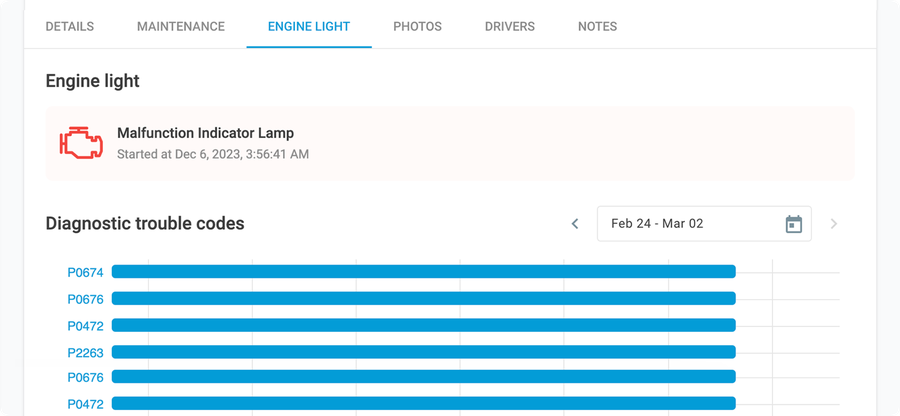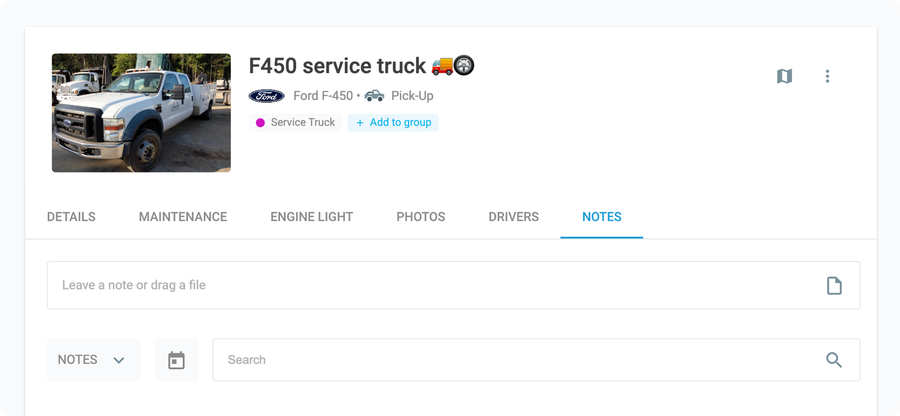Unexpected downtime presents a tangible setback for your fleet. Not only is your asset now off the road, but you have to tweak your operations and allocate finances to accommodate for it.
The good news is — it’s preventable.🥳
FleetChaser’s Preventive Maintenance Program
A preventive maintenance program is designed to monitor any potential maintenance issues. FleetChaser executes this with its multi-faceted preventive maintenance features.
Maintenance number tracking
You can review the status of every vehicle in your fleet list, along with percentage values for various maintenance metrics — air filters, oil changes, etc. That represents how soon they should be fixed. When you update the data according to a recent servicing you had done, the metrics will reflect the current state of the vehicle. These numbers can be used to predict future maintenance and help you plan out your fleet operations to optimally mitigate the impact of downtime on your assets.
Maintenance alerts

Whenever you get an engine code, FleetChaser will notify you of the issue, with a timeline of how long it lasted. In addition, there is a calendar of trouble codes, so you get a comprehensive view of alerts for every month.
Fleet Maintenance Log

You can record every maintenance procedure performed on your vehicles— even the most minor ones! Use FleetChaser to keep a maintenance history by adding notes in the Maintenance Tab. Add images and descriptions, so you can look back at a perfectly organized and detailed record of all maintenance work.
All the above-mentioned features combine to make a holistic, all-encompassing preventive program, operating to optimize your fleet.
Tips for streamlined downtime prevention and maintenance scheduling
A standard fleet management schedule is reliant on human information transmission rather than instant data updates and the efficiency of digital communications. The subsequent limitations result in metric inaccuracy and informational delays — which you do not want when managing a large number of vehicles, each with its individual upkeep costs.
In turn, an integrated fleet management software bypasses this by reading the data directly from the vehicle or having certain information be conveniently shared by the driver via the software, which takes mere minutes.
Base your schedule on precisely tracked metrics
A thorough set of maintenance metrics is the backbone of any maintenance schedule. Luckily, FleetChaser lets you see your vehicles on numbers — whether that be an odometer reading, usage reports, or specific alerts.
This way, you can plan out your maintenance schedule with accurate metrics, receive corresponding notifications, and adapt to changes in real time.
Leverage maintenance logs and history to predict future servicing schedule
Maintaining a running log of your assets' service history is crucial for having the best preventative maintenance program. Fleet managers can use it to create service reminders and better plan out the budget.
A fleet management software forecasts maintenance needs by monitoring and evaluating vehicle utilization, average daily usage and previous maintenance history. That way, you’re equipped with a well-rounded, data-driven approach to estimating repair and service procedures.
In conclusion
Long gone are the days of disorganized and inconvenient fleet management -— tracking assets and minimizing downtime can be easy and intuitive with the right software.
With FleetChaser, you can keep a full maintenance history of every vehicle in your fleet, get service reminders, trouble code alerts, monthly overviews and maintenance predictions. Have confidence in your fleet’s maintenance schedule, knowing it is backed up by accurate data obtained directly from the asset.
With a thorough fleet preventive maintenance program, fleet managers can count on a detailed maintenance plan that provides insights into future needs. FleetChaser’s extensive maintenance management and prevention systems optimize fleet operations, save costs and improve maintenance scheduling, ensuring timely repairs.




















